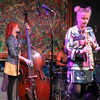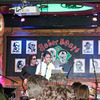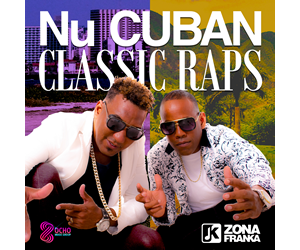Indice - Table of contents
Lo Nuevo[hide]
Reportes: From The St... : Jazz Plaza ...
Fotos: Tom Ehrlich : Irakere 50th Annivers...
Fotos: Tom Ehrlich : Irakere
Resenas: Joey Altruda Presents: El Gran ...
Reportes: From The St... : Cubadisco 2...
Timbapedia: 09. Interviews -... : Carlos del Pino ...
Fotos: Tom Ehrlich : 2023 Monterey Jazz Fe...
Fotos: Tom Ehrlich : 2023 Monterey Jazz Fe...
Fotos: Tom Ehrlich : 2023 Monterey Jazz Fe...
Fotos: Tom Ehrlich : 2023 Monterey Jazz Fe...
Grupos: Tirso Duarte
Grupos: Tirso Duarte : Discography
Grupos: Charanga Habaner... : 8. El bla bla bla
Grupos: Pupy y los que S... : Tirso Duarte
Fotos Del Día [hide]
SpanishEnglishPt. 3 - Song by Song - 2. Sube y baja
Sube y baja
(He decidido quedarme arriba)
de David Calzado
[aquí para la letra y análisis de formato]
«Sube y Baja» es el ejemplo más directo del enfrentamiento entre la Habanera y la Forever. Si bien es cantado por Aned Mota en primera persona, no hay duda de que el verdadero narrador del tema es su autor, David Calzado, «cantando» un mensaje destinado a la Charanga Forever a través de la voz de Mota. Esta idea es utilizada varias veces en el álbum. Las canciones han sido compuestas con tal ingenio que uno puede percibir de ellas por lo menos dos interpretaciones posibles. Uno podría imaginar, (a mayor grado con «El Bla Bla Bla») que Aned está dirigiéndose a una de sus pretendientes femeninas, pero podría ser igualmente Calzado reprochándoles a sus ex-compañeros de banda. Escribir la letra para que conlleve dos o hasta tres interpretaciones distintas es un aspecto no musical muy interesante de la timba, utilizada brillantemente no sólo por Calzado, pero por Klímax, NG La Banda, y por supuesto, por los maestros irrefutables del doble sentido, Los Van Van.
En este caso, la letra especula sobre el éxito de Calzado tras ser abandonado por los charangueros originales. («pero ahora me pregunto ¿qué hago? ¿me subo? ¿o me bajo?»). Pero en última instancia, como Mark Twain, nos informa que todo el barullo sobre su bajada son palabras nada más y que él permanecerá en lo más alto del escalafón timbero («¿qué cosa a ver? no veo a nadie en mi lugar. Mira, que yo lo busco y no puedo encontrar»). Luego explica que su éxito continuo se debe a su experiencia y sabiduría de lo que quiere la gente de la calle. (me robé la calle, ¿por qué?, por que la calle es mía, y me la como como un vaso de agua fría).
Recuerda que cada canción de este artículo cuenta con su propia página de letra/formato, y que puedes abrir un nuevo navegador a esa página y leer la letra mientras prosigues con esta descripción.
Como muchos arreglos timberos, «Sube y Baja» empieza con un brevísimo bocado de uno de los coros posteriores antes del breve pasaje introductorio de los metales y el cuerpo -- y ya que dicho bocado proviene del segundo tumbao de la canción, lo vamos a llamar «Tumbao 2», aún si bien inaugura el tema. Escuchamos el tumbao de piano sin el bajo mientras que Aned nos revela la letra del coro en rap, un rap tan cubano que nadie ni se prestaría a llamarlo «rap», pero es, en sí, lo que es. Es la voz hablada, no es canto, pero su ritmo complejo y totalmente cubano es algo intrínseco del pasaje y Mota lo ejecuta igual en todos los conciertos.

Este ejemplo es del disco [audio 6] y este otro es de una presentación realizada en la legendaria Tropicana de La Habana. [ejemplo de audio 7].
El tumbao de piano en sí es una preciosa composición en miniatura que, por lo menos en manos de Duarte, se presta a un sinnúmero de variaciones -- es un tipo de «timba jazz», muy placentero para el oyente, aun sin acompañamiento. Como en todos estos ejemplos de MIDI, la percusión secuenciada es el «click track» (ritmo génerico) que Duarte escuchaba mientras tocaba el tumbao. Luego le insertó un bajo de teclado. [ejemplo de audio 8]. Mientras que «Charanguero Mayor» cuenta con una mezcla aceptable, al menos en cuanto a grabaciones cubanas se refiere, nuestra queja general es que el piano no goza de la atención que merece, a diferencia de los discos anteriores de la Charanga Habanera original como «Hey You Loca», cuyas hermosas partes de piano brillaban galantemente sobre lo demás. Por ello nos es tan gratificante escuchar sólo al piano, pues se logra apreciar todos los atractivos y sutilezas.
Sea timba, salsa o jazz latino, la gran mayoría de los arreglos de estos estilos empiezan con una mini-composición para metales que dura de cuatro a ocho compases y que es frecuentemente utilizada nuevamente al final para concluir el tema. Dicho es el caso de los arreglos de la Charanga Habanera, pero aparentemente esta banda cuenta con una capacidad interminable de llenar este marco predecible de la pista con ideas ingeniosas y refrescantes. La introducción de metales de «Sube y Baja» es particularmente inteligente en cuanto a su entrada y su utilización de ritmos cruzados. Empieza en la última semicorchea del tercer tiempo, con un ritmo de «3 contra 2». Aquí lo escuchamos al inicio del tema [ejemplo de audio 9] y aquí al final [ejemplo de audio 10].
El cuerpo es muy corto, pero interesante. Son dos secciones «A» de cuatro compases, seguidas por una sección «B» que cae sobre dos frases similares de tres compases cada una conduciéndonos perfectamente al tumbao. Este es el primer tumbao de Tirso (en MIDI): [ejemplo de audio 11].
Tomemos un breve paréntesis para repasar la terminología timbera, para aquéllos que no han hecho seguimiento de los demás artículos publicados en timba.com. La pauta básica del arreglo timbero es de seguir al cuerpo (la canción en sí) con uno o más «tumbaos», una serie de progresiones armónicas reiterativas con contagiosas figuras rítmicas muy particulares de la canción que son planteados por el piano y el bajo. Generalmente se marca una transición al momento de introducirse un nuevo tumbao, donde la percusión ejecuta figuras rítmicas improvisadas o predispuestas (redobles o bloques) y el vocalista principal le canta o habla al público, preparándolo para el contenido lírico del coro siguiente. Esto es seguido por los «coros», breves interjecciones vocales, rítmicas y reiterativas, que son combinadas con otras interjecciones vocales del cantante principal, lo cual en Cuba se conoce como «las guías». Se alternan estas secciones vocales con uno o más interludios por parte de los metales, o en otras palabras, los famosos «mambos».
Casi toda la salsa y la timba está basada en este formato y la música de la Charanga Habanera no es la excepción, pero dentro del formato, Calzado y los demás arreglistas de la CH cuentan con una imaginación sin fondo. Por ejemplo, veamos lo que sucede frente al primer tumbao:
En primer lugar, el bajo deja de tocar al compás, restando en notas sostenidas, la primera de las cuales cambia el tono armónico provisionalmente de mayor a menor. La ausencia de una línea de bajo corriente resalta el tumbao de piano mientras que Aned varía levemente el rap con el cual inauguró el tema. Hacia el final de este rap los precusionistas entran con un bloque.
rap (4)
Aned: y tú sabes que yo estoy ahí
en la pelea que te gusta a tí
ay, pero ahora me pregunto
¿qué hago? ¡mira!
¿me subo? ¿o me bajo? [bloque] [ejemplo de audio 12]
Luego entra el coro. Estamos acostumbrados a canciones de salsa que consisten en alternar coros y guías, pero aquí los parámetros son borrosos. El cantante principal refuerza el coro, y en la sección siguiente, el coro refuerza su guía. Pero el ingenio de formato está velado por la belleza melódica de Aned y la guía en sí. [ejemplo de audio 13]
coro 1 (4)
coro: yo solo quiero que mi pueblo diga
Aned: ay Dios!
coro: si voy pa’bajo o si voy pa' rriba
yo solo quiero saber lo que hago
si voy pa' arriba o si voy pa' abajo
guía (4)
Aned: porque será que me mantengo
y de la cima no me caigo
coro: porque sigues piango piango
Aned: pero no quiero dañar
yo sólo quiero encontrarme con el
personal [ejemplo de audio 13]
En el segmento siguiente Aned hace más que sólo reforzar el coro -- de hecho canta toda una guía por encima. Luego canta su guía normal, la cual nos conduce al primer mambo. Normalmente el cantante descansa y los metales toman su lugar, pero el mambo es reforzado primero por Aned y luego por el coro. Con todo esto queremos demostrar que la explosión creativa de la timba ha sido parcialmente instigada por la sencilla idea de tomar las cuatro partes básicas de la fórmula salsera y mezclar y cotajerlas infinitamente para generar nuevos y emocionantes conceptos. Hay momentos en los cuales nos parece que el mambo, el coro, el cantante principal y las varias partes de la instrumentación están inmersos en una gran conversación, todos dialogando al mismo tiempo, pero nunca estorbando o poniéndose en medio de los otros. [ejemplo de audio 14]
coro 1 (4) [¡con guía polifónica!]
coro: yo solo quiero que mi pueblo diga
Aned: ay ahora yo quiero que diga
coro: si voy pa‘abajo o si voy pa' arriba
Aned: yo sigo pa' arriba
coro: yo solo quiero saber lo que hago
Aned: ¿qué?
coro: si voy pa' arriba si voy pa' abajo
guía (4)
Aned: no es que yo sea lo más grande
pero la cosa está que arde
ay!, la cosa está que hierve
la cosa está caliente
ya no es tan fácil sofocar a la gente
qué va!
mambo 1 (8)
Aned: coge tu mambo
y mira al Gordo de Carmelo guarachando
yo!
coro: yo me pregunto que me voy a hacer
Aned: pregúntale a Noel ... o a Dantes
o a Orlandito, o a Lazarito
si mira como hay gente aquí!
yo [ejemplo de audio 14]
Esto es seguido por un tratamiento completo del Tumbao 2 (el mismo que vimos al comienzo) y luego volvemos al Tumbao 1, pero con un coro distinto y más corto. En esta ocasión, el coro y la guía tienen duraciones distintas, y luego de la última guía, el coro empieza de nuevo y es prolongado, introduciendo el tercer tumbao de la canción. [ejemplo de audio 15]
Tumbao 3 cuenta con la misma progresión armónica del Tumbao 1, pero la parte de piano es distinta y cabe cabalmente con el estilo improvisador de Tirso Duarte. El próximo ejemplo MIDI no deja de asombrarme: [ejemplo de audio 16]
Esta es la sección más larga de la canción con una gran cantidad de combinaciones distintas de coros, guías y mambos, desembocando en un segmento que es realmente espectacular. Empieza como un mambo, pero el coro y Aned se entrometen en la segunda frase. Es ahí donde las cosas se ponen interesantes. Mientras que los metales tocan las anacruzas a lo que aparentemente será una nueva repetición del mambo, un nuevo coro (coro 5) traslapa la frase del mambo, y ¡dos tiempos más tarde, aparece Aned como si estuviese cantando en canon con el segundo grupo de coristas! Es un efecto precioso. Luego, al dividir a los cantantes en dos grupos, ambos coros se juntan durante dos repeticiones y empieza otro mambo que reemplaza el segundo coro y sirve de respuesta al coro inicial que ha cambiado sólo levemente (porque la calle es mía, mía mía mía y me la tomo con un vaso de agua fría). Debes escuchar este ejemplo algunas veces antes de captar de lleno su verdadera intención e ingenio. [ejemplo de audio 17]
mambo 2 (2)
segunda mitad de coro 4 (2)
coro: porque la calle es mía
y me la como como un vaso de agua fría [bloque]
mambo 2 (2)
segunda mitad de coro 4 (2)
Aned: ay, ¿por qué?
coro: porque la calle es mía
Aned: ¿y yo?
coro: y me la como como un vaso de agua fría
coro 5 (4) [coro 5 tiene la misma terminación del coro 4]
coro: amiguitos vamos todos a cantar
Aned: ay, amiguitos vamos todos a cantar, mamá [¡entrada canónica!]
coro: porque tenemos el corazón feliz
porque la calle es mía
Aned: ¿y yo?
coro: y me la tomo como un vaso de agua fría
coro 5 (4)
coro: amiguitos vamos todos a cantar
Aned: ya bailar
coro: pa' que herremos un corazón feliz
Aned: ¿por qué?
coro: porque la calle es mía
Aned: ¿y yo?
coro: y me la como como un vaso de agua fría [bloque] [ejemplo de audio 17]
Más tarde tenemos dos guías memorables que son de hecho «citas» de otras canciones, otro recurso común de la música latina y del jazz. La idea es de tomar una breve viñeta de otra canción y hallar la forma de manipularla para que se ajuste correcta e inteligentemente frente al tumbao. La primera hace referencia a un tema antiguo de Los Van Van, obra de Rodolfo Vaillant, «Se Muere la Tía», [ejemplo de audio 18], y la segunda es una frase sumamente adictiva que fue prestada de Yeni Valdés (actualmente de Los Van Van) por un ex-charanguero, Michel Maza, y finalmente utilizada como cita aquí por Aned. Las melodías de ambas citas levantan vuelo magníficamente sobre el tumbao de Tirso, y también tienen sentido dentro de la letra. El coro en sí está comparando los conocimientos de Calzado de «la calle» con la facilidad con la cual él tomaría un vaso de agua fría; la canción de Los Van Van se trata de una tía que se muere de sed, y la cita de Yeni es de una niña sedienta que pide agua a su mamá. (La palabra agua también es jerga timbera para explicar que la música está «demasiado» abrazante y que agua es necesaria para apagar el fuego. Y ¡eso también se aplica aquí!)
coro 6 (2) [ejemplo de audio 18b]
coro: porque la calle es mía, mía, mía
y me la como como un * vaso de agua fría [*=bloque]
Aned: sí!
mambo 3 (2)
Aned: se muere de sed la tía
¿por qué? [referencia a «Se Muere La Tía» por Los Van Van]
coro 6 (2)
coro: porque la calle es mía, mía, mía
y me la como como un vaso de agua fría [bloque]
mambo 3 (2)
Aned: hay agua mamá
niñito tiene sed [referencia a una guía por Michel que era originalmente de Yeni Valdés]
coro 6 (2)
coro: porque la calle es mía, mía, mía
y me la como como un vaso de agua fría [bloque] [ejemplo de audio 18b]
El bloque nos trae el tumbao final, el cual sirve de base para una de mis improvisaciones favoritas de Tirso Duarte. Hacia la mitad, Tirso, sin quebrar el flujo de su tumbao, alcanza a citar la canción «Birdland» de Weather Report, esto mucho antes de que Los Van Van hicieran la misma alusión en el tema titular de su trabajo discográfico más reciente. [ejemplo de audio 19]























